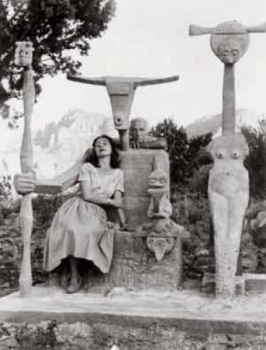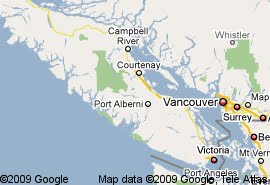
Dorothea Tanning and Max Ernst with his sculpture, Capricorn
Photograph by John Kasnetsis
1947
American painter Dorothea Tanning, b. Galesburg, Ill., Aug. 25, 1910, learned to paint, she claimed, by visiting art museums.
She attended Knox College in Galesburg, studied art in Chicago, and in 1935 moved to New York City, where she supported herself with advertising art and painted in her spare time. A commercial artist in New York, she began painting as a professional after meeting a group of French surrealist painters that included Max Ernst, whom she married in 1946.
Tanning's paintings have evolved from her early surrealist evocations of perverse children's games and fantasies to experiments with different painting and, later, sculptural approaches--although her involvement with symbolic and dream material has remained constant.
Her Hotel du Pavot, an installation in cloth sculpture, is in the permanent collection of the Beaubourg Museum in Paris.
http://www.ibiblio.org/wm/paint/auth/tanning/
the WebMuseum
Surrealism: A 20th-century literary and artistic movement that attempts to express the workings of the subconscious by fantastic imagery and incongruous juxtaposition of subject matter.
Surrealism, movement in visual art and literature, flourishing in Europe between World Wars I and II.
Surrealism grew principally out of the earlier Dada movement, which before World War I produced works of anti-art that deliberately defied reason; but Surrealism's emphasis was not on negation but on positive expression.
The movement represented a reaction against what its members saw as the destruction wrought by the "rationalism" that had guided European culture and politics in the past and that had culminated in the horrors of World War I.
According to the major spokesman of the movement, the poet and critic André Breton, who published "The Surrealist Manifesto" in 1924, Surrealism was a means of reuniting conscious and unconscious realms of experience so completely that the world of dream and fantasy would be joined to the everyday rational world in "an absolute reality, a surreality."
Drawing heavily on theories adapted from Sigmund Freud, Breton saw the unconscious as the wellspring of the imagination.
He defined genius in terms of accessibility to this normally untapped realm, which, he believed, could be attained by poets and painters alike.
The major Surrealist painters were Jean Arp, Max Ernst, André Masson, René Magritte, Yves Tanguy, Salvador Dalí, Pierre Roy, Paul Delvaux, and Joan Miró.
With its emphasis on content and free form, Surrealism provided a major alternative to the contemporary, highly formalistic Cubist movement and was largely responsible for perpetuating in modern painting the traditional emphasis on content.
Souce:
http://www.ibiblio.org/wm/paint/glo/surrealism/
the WebMuseum

No comments:
Post a Comment